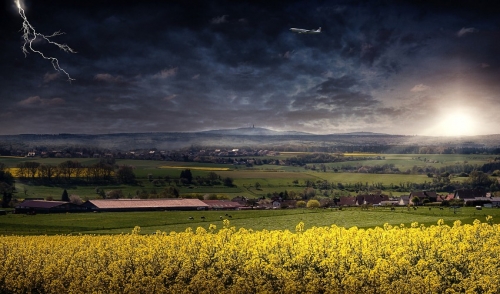{article.name}
Storm Preparation Tips for Horse & Cattle Owners

- Share this:
- Share on Facebook
- Pin on Pinterest
- Tweet on Twitter
Properly caring for horses or livestock during a threatening storm requires careful planning and preparation. No one is immune to disaster and that’s why we implement strategies and plans to overcome dangerous weather. No matter what the disaster may be, it never hurts to be prepared. This is especially true when you have livestock counting on you to manage their well being.
In this article you will find a few tips on how to successfully prepare for storms and disasters. The first tip is to stay up to date on all of your horses and cattle’s records. Keep a binder or folder with a photo of each animal and a profile. In the event one goes missing, you will be able to recognize it immediately. Also, keep records of vaccinations especially proof of EIA testing for horses, and a copy of the animal’s registration papers. You can also use other identifiers of proof of ownership such as a tattoo or microchip, permanent marker on the hooves of the horses, cattle ear tags printed with waterproof ink, or luggage tags with your contact information that can be attached to the horses halter or collar. The second tip is store an emergency kit in an easily accessible location. It’s very important that this kit and its contents are used only in the case of emergencies. When the storm finally comes, you don’t want to be caught without an umbrella. To build an effective kit, start with a lightweight plastic barrel or a large tackle box. Make sure the kit has the ability to travel easily just in case you need to move it or toss it in the back of a vehicle. Within the kit, pack bandages, antiseptics, thermometer, scissors/knife, pain relievers, radio, flashlight, and extra batteries. Also keep a few blankets, a tarp, fly spray and extra halters with lead ropes. Try to keep a properly fitted halter and lead rope for each horse. Avoid using nylon halters and lead ropes, as they are easily flammable. In addition to a kit, stash emergency supplies and tools in different and protected locations around your property. Stock basic supplies such as a toolbox, duct tape, fuel, and a fire extinguisher so that they are easily accessible when you need them. Another tip is to stockpile at least 72 hours of feed and water for your livestock. If a storm hits and the power is down along with closed roads, there will be limited access to stores with feed. Be sure to cover your hay to keep it dry and keep all of your grain in watertight containers.
Finally, make sure you always have an evacuation route plotted and know where to take all of your livestock. Keep your truck full of gas and make sure the trailer is already hitched. If you must leave your horses and cattle behind, be sure to leave them in safe areas away from barns and flood areas. This decreases the chance of your livestock being injured by a collapsing barn or falling tree. There’s plenty to do in preparation for the next big storm and each farmer and farm are different. Regardless of what’s headed your way remember these tips or come up with a few of your own, because the more prepared you are, the better chance you and your livestock have for survival.
Special Offers
We are constantly adding new specials to our site. Be sure to check back often!


Comments